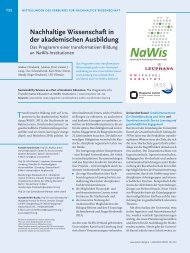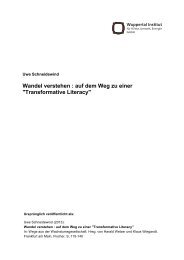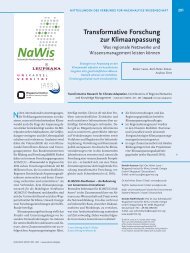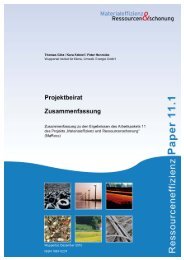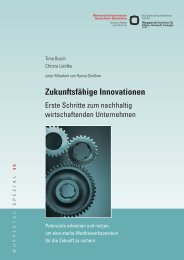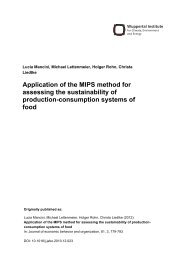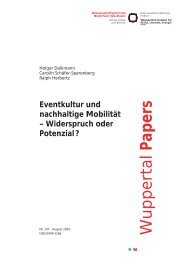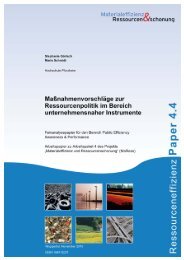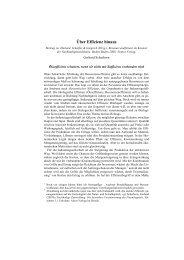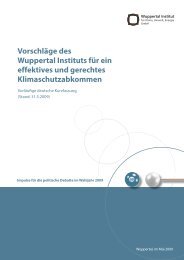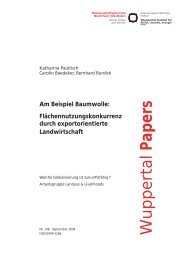Resource Efficiency Atlas - Publication Server of the Wuppertal ...
Resource Efficiency Atlas - Publication Server of the Wuppertal ...
Resource Efficiency Atlas - Publication Server of the Wuppertal ...
Create successful ePaper yourself
Turn your PDF publications into a flip-book with our unique Google optimized e-Paper software.
68<br />
Chapter 4: Strategic starting-points for more resource efficiency<br />
4 Strategic starting-points<br />
for more resource efficiency<br />
The project results indicate that <strong>the</strong>re are a large number<br />
<strong>of</strong> innovative technologies and products for resource efficiency<br />
available. Since <strong>the</strong>ir implementation and relevant<br />
knowledge is not widely spread, support is necessary. This<br />
general conclusion can be drawn based on <strong>the</strong> expert<br />
interviews and <strong>the</strong> identified examples. In this chapter,<br />
Ressourceneffizienzatlas<br />
<strong>Resource</strong> <strong>Efficiency</strong> <strong>Atlas</strong><br />
<strong>the</strong> strengths and weaknesses <strong>of</strong> technical solutions for<br />
resource efficiency are identified based on <strong>the</strong> result <strong>of</strong><br />
<strong>the</strong> interim results <strong>of</strong> <strong>the</strong> <strong>Resource</strong> <strong>Efficiency</strong> <strong>Atlas</strong> project<br />
(chapter 4.1), followed by a description <strong>of</strong> starting points for<br />
increased resource efficiency (chapter 4.2).<br />
4.1 Strengths and weaknesses <strong>of</strong> technology and product development<br />
The following questions are central in light <strong>of</strong> <strong>the</strong> technical<br />
solution development for increasing resource efficiency:<br />
What is <strong>the</strong> motivation for resource efficient technology<br />
and product development to date?<br />
What are <strong>the</strong> counteracting forces?<br />
What are possible risks?<br />
In order to answer <strong>the</strong>se questions a SWOT-analysis<br />
(strengths, weaknesses, opportunities, and threats) <strong>of</strong><br />
“technical solutions for increasing resource efficiency” was<br />
conducted from a technology and product development<br />
perspective. The project experiences are summarised by<br />
means <strong>of</strong> <strong>the</strong> SWOT-analysis against <strong>the</strong> background <strong>of</strong><br />
accelerated resource efficient technology and product development.<br />
A particularly important issue is related to advantages<br />
and disadvantages coming along with a focus on<br />
resource efficiency during technical solution development.<br />
For this purpose, strengths and weaknesses <strong>of</strong> technology<br />
and product development (internal perspective, table 2) as<br />
well as opportunities and threats – with regard to frame-<br />
work conditions for development (external perspective,<br />
table 3) – are considered. This assessment is based on a<br />
cross-analysis <strong>of</strong> results derived from expert interviews<br />
and example collection. Fur<strong>the</strong>rmore, observations from<br />
<strong>the</strong> research process are included to ensure a comprehensive<br />
analysis.<br />
The internal perspective on technology and product de-<br />
velopment indicates that some companies pr<strong>of</strong>it already<br />
today by focusing on resource efficiency during technol-<br />
ogy development. These companies gain from lower price<br />
risks and improved supply conditions. In addition, companies<br />
can pr<strong>of</strong>it from a positive image <strong>of</strong> resource efficiency<br />
allowing <strong>the</strong>m to open up new markets. With respect to<br />
<strong>the</strong> production process, resource efficiency can lead to<br />
cost savings if, for example, material savings and waste prevention<br />
are implied. However, this is not always <strong>the</strong> case:<br />
For instance, material substitution might lead to a lower<br />
amount <strong>of</strong> material input due to higher stiffness. Still, total<br />
costs <strong>of</strong> production might increase because <strong>of</strong> higher<br />
material costs.<br />
A key obstacle towards resource efficient technology<br />
development is <strong>the</strong> necessary investment cost primarily<br />
paid for by <strong>the</strong> manufacturer. In many cases <strong>the</strong> production<br />
process becomes more expensive as well: One example is<br />
<strong>the</strong> production <strong>of</strong> hybrid cars, which are more expensive<br />
than comparable vehicles. They also require higher resource<br />
use during <strong>the</strong> production process. The price premium<br />
is passed on to customers as <strong>the</strong>y benefit from lower<br />
fuel consumption. Due to <strong>the</strong> high investment costs for this<br />
kind <strong>of</strong> innovations <strong>the</strong> demand is limited.<br />
Ano<strong>the</strong>r obstacle might be <strong>the</strong> relevance <strong>of</strong> o<strong>the</strong>r sustainability<br />
<strong>the</strong>mes. <strong>Resource</strong> efficiency is only one issue<br />
within <strong>the</strong> holistic perspective <strong>of</strong> sustainability. Important<br />
expertise is <strong>of</strong>ten missing such as assessment with<br />
expanded indicator systems in <strong>the</strong> development stage to



